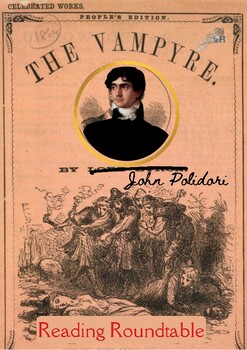Polodori’s The Vampyre: Horror Reading Roundtable and Annotation Guide
- PDF
Also included in
- Halloween Horror Interdisciplinary WeekExplore primary sources, read THE original vampire story with your students, and have fun learning about a monster for a week! Shorts: Roundtable and Annotation Discussion PrepHorror is fun! Most of the best horror short stories are full of complex, adult themePrice $13.00Original Price $17.00Save $4.00
Description
Halloween Horror Shorts: Roundtable and Annotation Discussion Prep
Horror is fun! Most of the best horror short stories are full of complex, adult themes of dealing with your inner demons as much as the eternal ghoul down the street. If you are a more advanced literature teacher looking to give your students some challenging material, these two independent activites work perfectly with the first vampire novel. Inspired by the same conversation between Percy and Marry Shelley, Lord Byron, and John Polidori that birthed Frankenstein, The Vampyre echoes through modern literature, film, and culture.
Written in 1819, it might be the birth of horror but it is also a difficult book to grasp for modern readers. Break this text into two readings, using the Annotation guide then the Reading Roundtable to hone multiple skills, including reading older, more complex English.
Whippoorwill Horror Annotation Guide is a discussion preparation where students use a structured set of color-coded categories to highlight the text. This is best done physically with colored markers, but, of course, any color or ‘highlighting’ method will do. Students must use the colors associated with the categories:
Patterns- Highlight language patterns that you find interesting
Modus Operandi- Highlight motivations or revealing actions
Narrative- Highlight pivotal points in the plot
Reactions- Highlight note worthy reactions from characters
Paranormal- Highlight the unnatural or otherworldly
Themes- Highlight relevant themes
In the margins of your document, students should
1. Define tough words in your own words
2. Connect your annotations to other media
3. Explain why you highlighted with key words
Once they return to class, have a structured conversation around the reading. Board and their annotated quotes on the board to lead your class toward the answer: What was the message of this narrative? and What about this story frightens you?
Whippoorwill Humanities’s Short Story Reading Roundtable is a Literature Circle; a skills-based independent reading activity that supports a student-centered discussion on a given reading. These activities are for those teachers who might be between books, want to read a thematically similar text, or just want a quick Homework then Discussion lesson.
Assign the sheets for homework, and when the class next meets the students engage in a discussion that is independent of the teacher, whose only function is to move the conversation along (only if all else has failed) or answer questions.
The goals here are self-explanatory, but if you use this reading activity with a large class, form smaller groups for the discussion. No student should do one role more than twice throughout the year. These are easy to lean on, as they produce some fantastic discussions, but use them sparingly throughout the year to keep them fresh. Also encourage students to cite pages and format the quotes as they would in an essay, so this skill becomes a habit!
Materials Included
PDF Text
Role Sheets
Annotation Guide
Roles
Discussion Leader - leads our day’s discussion
Scene Artist - draws and quotes the two most important scenes
Language Highlighter - finds interesting phrases/words that make the reading better
Meaning Connector - finds connections to themes or meaningful ideas around the world
Character Watcher - documents character developments
Culture Commenter - finds meaningful differences/similarities between his/her culture and the one depicted in the text
Story Condenser - summarizes the reading, chooses three biggest moments to highlight
Vocabulary Finder - find the 8 most important words, defend your choices
Passage Person - find the 5 most important quotes, defend your choices
Assessment
There are many ways to ‘grade’ a reading roundtable, but starting with completion of the role sheet, have the Discussion Leader (or yourself) mark the number of meaningful comments each student produces throughout the conversation. Also mark when a student asks a follow-up question or makes a valid point to counter someone else’s assertion.






